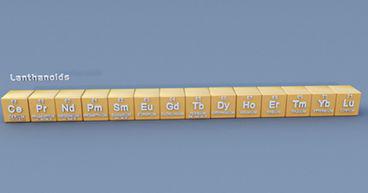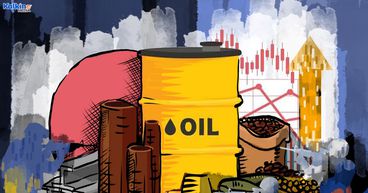Uranium
77.4 USD/oz -2.1 (-2.64%) (Last updated - July 03, 2025 08:58 PM UTC )48.95
48.95
48.95
30.35 - 64.5
-9.63%
About
| Performance USD/oz | Change |
| 5 Day | -2.7% |
| 1 Month | -4.68% |
| 3 Months | -9.63% |
| 6 Months | -9.63% |
| 52 Week | -9.63% |
July 03, 2025 08:58 PM UTC
Data Powered by Stockdio. Data delayed by 5 minutes unless otherwise indicated.Uranium is one of the heaviest of all naturally occurring elements in the periodic table. Uranium occurs in nature in low concentrations and in two natural isotopes- uranium-238 and uranium-235. Nearly 99.3% of all-natural uranium is U-238, and the remaining 0.7% is isotope U-235, which is in high demand as they are radioactive and highly ‘fissile’.
Under the right conditions, U-235 atoms can be split and, in due process, emit high energy. This is the basic principle used in atom bombs and nuclear energy reactors. The basic difference between an atom bomb explosion and a nuclear reactor chain reaction is in an atom bomb explosion, energy is released in a very short span of time without any control over the reaction, while in a nuclear reactor reaction, a uranium atom is split under controlled conditions to produce energy for generating power.
A uranium atom contains 92 protons, and in case of U-238, there are 146 neutrons, and U-235, contains 143 neutrons. U-235 represents the sum of 92 protons and 143 neutrons.
Nuclear energy
U-235 isotopes are used in the commercial production of electricity. In a nuclear power plant, U-235 isotopes undergo a fission process where a uranium atom is split into two smaller nuclei and this process gives rise to three new neutrons and heat energy. This heat is used to convert water into steam, which is used to move electric generator turbine propellers and thus generates electricity.
Nuclear energy is considered as clean energy thanks to zero carbon emissions. Currently, around 10% of the global electricity is produced using nuclear energy.
As of 2022, Kazakhstan is the largest producer of uranium and contributes to nearly 50% of all global production. Australia holds the largest resource of uranium and is the third-largest producer.
The uranium market has become important in 2022 as global economies are trying hard to cut their carbon emission. Post the 2011 Fukushima accident in Japan, the nuclear energy market has been at a standstill.
| Code | Company | Price | Chg | %Chg | High | Low | Volume | Market Cap | |
|---|---|---|---|---|---|---|---|---|---|
| Basic Materials |
|
BHP Group Limited | 1,840.500 | 5.5 | 0.298 | 1,840.500 | 1,829.000 | 442,509 | 134,687.982 M |
| Energy | BKY | Berkeley Energy Ltd | 28.500 | 0 | 0.00 | 29.000 | 28.000 | 406 | 86.930 M |
| Energy | EME | Empyrean Energy Plc | 0.020 | 0 | 0.00 | 0.021 | 0.019 | 2,288,712 | 7.312 M |
| Healthcare |
|
MyHealthChecked Plc | 10.250 | 0.5 | 4.651 | 11.500 | 10.075 | 6,477 | 5.071 M |
| Technology | PEN | Pennant International Group plc | 27.500 | 0 | 0.00 | 27.800 | 27.020 | 76,792 | 11.434 M |
| Basic Materials |
|
Power Metal Resources plc | 13.000 | 0.5 | 4 | 13.500 | 12.000 | 74,228 | 16.501 M |
| Basic Materials |
|
Rio Tinto PLC | 4,266.500 | 29.5 | 0.687 | 4,287.500 | 4,255.500 | 1,174,097 | 90,846.077 M |
Frequently Asked Questions
Enriched uranium isotope U-235 is used as a fuel for nuclear power reactors to generate electricity. Smaller versions of reactors are used in aircraft carriers and submarines instead of diesel or gas generators. Due to uranium’s unmatched energy density, they can run for long durations without refuelling. They provide a 24X7 reliable and clean source of energy.
Enriched uranium is also used in nuclear weapons. These bombs could be used as a projectile in rockets and missiles. Nuclear explosions cause a vast level of destruction. The world has already witnessed the destruction caused by nuclear bombs during World War II when two nuclear bombs were dropped on Hiroshima and Nagasaki in Japan, killing hundreds of thousands of people.
Prolonged exposure to uranium can cause radiological and chemical poisoning. Exposure to uranium can cause kidney poisoning. Consuming food containing uranium or breathing uranium dust can cause poisoning and subsequently enter the bloodstream. This may lead to acute kidney failure and eventually death with a very high level of uranium consumption.
Uranium radiation also has significant health consequences. Workers associated with uranium mining and processing can get affected by exposures that can lead to cancer. To make it worse, cancer caused by radiation is indistinguishable from ‘naturally occurring’ cancer and it is seen in patients many years after the exposure.
Uranium prices jumped to US$53/lb during the first half of 2022. According to the data published in Resources and Energy Quarterly’s June 2022 edition, the prices are expected to move further to US$61/lb by 2024.
Post the Fukushima nuclear reactor accident, triggered by a Tsunami, several countries started to withdraw or postpone their nuclear power program. As a result, the uranium mining industry witnessed lesser interest from investors. As a consequence, multiple exploration and production projects were halted or abandoned.
Since the 2015 Paris Agreement on Climate Change and in a less-severe COVID-19 pandemic, the world is again looking at uranium as a clean and reliable energy source.
Australia holds the world’s largest resource of uranium and is currently the third-largest producer. The country produced nearly 4,000 tonnes of uranium for FY2021-22, which is expected to increase to 5,480 tonnes for the next fiscal year.
Interestingly, Australia does not have any commercial nuclear power plant. Hence, whatever is mined is exported to international buyers.
Most of the current production is coming from three mines in Australia- Olympic Dam, Ranger and Four Mile. The production is expected to increase significantly by 2027, as Boss Energy’s Honeymoon mine is expected to commence full production from 2027.





